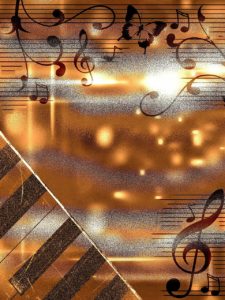Estimated reading time 4 minutes
Table of Contents
Why Use the Guitar to Learn How to Sing in Tune Like an A Cappella Singer?
Do you want to know a good way to train your ear to harmonize in tune? All you need is a guitar. Read more to learn how to sing in tune like an a cappella singer.
- When open D tuning is fine-tuned using harmonics, it makes playing the guitar a lot of fun. However, it also fashions a powerful ear training tool to help vocalists sing in tune.
- The guitar tuning creates a model of what a well-tuned chord should sound like. It helps singers who struggle with intonation to experience good harmony for themselves.
- Singing to the piano teaches vocalists to sing vague harmonies, because piano technicians tune the piano to equal temperament. Equal temperament compromises some of the harmonic intervals in order to limit the piano to just twelve notes. The piano makes a poor harmonic sound model.
- The fine-tuned guitar fills the gap, providing a much-needed harmonic sound model.
Alternately, you can use sing-along soundtracks to learn how to sing in tune:
This article uses technical musical terms. For definitions, see the Glossary at the end of the post.
A Cappella Group Video
How to Tune the Guitar
To tune the guitar, please refer to the blog article:
The post also shows how to play the chords in open D. After tuning the guitar to open D, you can use it as an effective sound model for singers.
Exercises for Mastering Singing in Tune Like an A Cappella Vocalist
Mobile users: for best results reading the music, tilt your screen 90o to the right.

The above vocal exercise starts with the notes of the top four strings of the fine-tuned open D guitar tuning.
- The sopranos match their note to the first string, the altos to the second string, the tenors to the third string, and the basses to the fourth string.
- The exercise fits the vocal range of each voice type fairly well. Nevertheless, the basses will probably need to drop out on the last three bars.
- Once the singers have the exercise down, switch to the popular vocal warm-ups. For example, one warm-up has singers changing the vowels (Mee, Meh, Mah, Moh, Moo) while singing the same notes.
- The guitarist can play a selected string to bring out one part if the vocal section in question needs help with their part.
Alternately, singers working by themselves can work on singing different parts of the chord by switching which string they are singing with. Also, it is good ear training for flexible pitch instrumentalists as well.
Tips for Mastering Singing in Tune Like an A Cappella Singer
Take time tuning up the vocal harmonies.
- Notice how the chords are all whole notes and the tempo is a slow 55 beats per minute (bpm). This allows the singers enough time to get the chords in tune. Feel free to hold it for longer if necessary. For best results, sing without vibrato.
- The guitarist shifts the chord up one fret each time the chorus sings the next higher harmony. The guitar can also accompany songs. If the guitarist gets drowned out by the chorus, he can play with light to moderate distortion.
- Solfege (Do, Re, Mi) can be an effective method for working on sight singing and melodic tuning. However, it will not train the singer’s sense of harmonic intonation.
- Harmonic sound models, provided by retuned synths and guitars can teach you how to sing in tune like an a cappella singer.
For those people who are not comfortable retuning instruments:
© 2020 Geoffrey Keith
Join me for in-person or online lessons!
Glossary
Harmony and Melody Tune Differently
Have you ever felt embarrassed because someone said you sang or played out of tune? Does harmonizing seem like a puzzle you can’t solve? Knowledge is power. I will show you how harmony and melody tune differently, and how it impacts singing and playing in tune. Estimated reading time 4 minutes.
Read MoreSinging Shape Note Parallel Minor Melodies
Have you learned how to sightread relative minor melodies, but want to be able to sing parallel minor too? We’ve already learned about La based shape note solfege minor melodies. In this post, you’ll learn about Do based shape note solfege as well. Read more to find out about singing shape note parallel minor melodies. Estimated reading time 3 minutes.
Read MoreWhat’s the Key Difference Between Countertenor, Baritone, etc?
Do you want to know what voice type you are? All the voice types discussed in this post are from the pool of male singers used in chorus, opera, musical theatre, and pop music. Some of these male vocalists can sing very high, while others can sing very low. However, it’s the quality of his voice that makes a male singer one voice type versus another. Keep reading “What’s the Key Difference Between Countertenor, Baritone, etc?” to learn what makes a singer a countertenor, tenor, baritone, or bass and how to tell them apart. Estimated reading time 2 minutes.
Read MoreWhat Does Prodigy Mean and Do They Have Elite Musical Talent?
Do you have a musical prodigy on your hands? Do you need information about how your musical child or student learns? Musical giftedness can emerge as early as one to two years old and usually appears before age six. It’s characterized by a rage to learn. Keep reading “What Does Prodigy Mean and Do They Have Elite Musical Talent?” to get examples of this shocking musical ability. Estimated reading time 5 minutes.
Read More




![Prodigy Meaning (Examples of Special Talent in Music) [Video] - Children Playing Music - Sing the Charming Song London Bridge Is Falling Down](https://successmusicstudio.com/wp-content/uploads/2024/05/Prodigy-Meaning-Examples-of-Special-Talent-in-Music-Video-Children-Playing-Music-300x200.jpg)